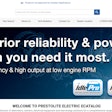
Cummins’ theme for its 2013 and 2014 engine program is “Better where it counts,” a sentiment reflected by Rich Freeland, vice president and president of the company’s engine business who says, “Customers can count on Cummins. We met the EPA 2010 standard on time and our engines have earned their industry-leading reputation for great reliability and fuel economy. Our product development teams are now delivering even better products where it counts — to our customers — and these new, 2014-compliant engines are a sign of that.”
Freeland says Cummins will not change its diesel engine lineup in any significant way this coming January: The company’s full slate of diesel engines — from the medium-duty ISB6.7 to its flagship ISX15 will be available and all will be ready to meet the 2014 fuel economy and greenhouse gas regulations a full year ahead of schedule.
The only major pending change to the Columbus, Ind., company’s power offering will be a new, natural-gas version of the ISX15. The new engine is currently in development as a spark-ignited alternative for fleets and operators concerned with rising diesel fuel prices, the company says. Cummins is already producing on-highway, spark-ignited natural gas engines with Cummins Westport — its joint venture with Westport Innovations in Vancouver, B.C.
The new 15-liter development project is said to be significant, however, in that it is being developed solely by Cummins. Ed Pence, vice president and general manager of Cummins heavy-duty engine business, notes that the new 15-liter will be based on the existing ISX15 platform and be capable of burning compressed natural gas, liquefied natural gas or bio-methane fuel. Pence adds that Cummins expects to begin field-testing the new engine early next year and begin production in early 2015.
Additionally, Cummins announced the introduction of its new Fleetguard FF5782 fuel filter. According to Joesph Saoud, vice president of Cummins Filtration, the new filter, which uses nanotechnology-based filtration media is “revolutionary” and designed to trap 98.7 percent of all particles as small as 4 microns. In layman’s terms, Saoud says the new media can effectively trap particles 12 times smaller than anything the human eye can see.
The result, he says, is a filter that now offers Cummins customers protection that is 13 times better than its predecessor, allowing engines and engine components to last significantly longer in the field and delivering up to a 25 percent reduction in total cost of ownership.
Cummins Filtration also has announced the launch of Filter Change, its filter recycling management program. This program is aimed at partnering with service providers and fleet locations throughout the U.S., and eventually globally, to reduce the number of metal filter cans and used media elements being dumped into landfills, Cummins says.
Within the past three months, the program has seen more than 50 metric tons of previously landfilled metal now being recycled, which Cummins says in turn creates an avoidance of 40 metric tons of greenhouse gas emissions in the environment.
“As service providers, our customers are already required by government regulations to manage waste oil and filters. This program is built around helping them take it to the next level, to rethink how they manage that waste for the future,” says Matthew R. Tullai, executive director, marketing and sales – Cummins Filtration. “Proper filter recycling not only makes their customers feel good about where they do business, but it also keeps our customers ahead of changing government waste management requirements.”











